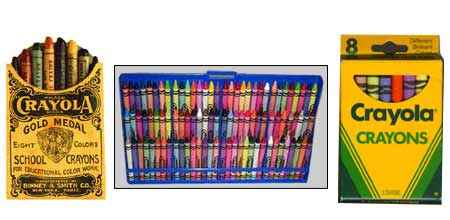Crayola Crayons

Synopsis of Toy
Opening a new toy ranks among the most sublime of this world’s pleasures. And opening a new box of Crayola Crayons might be the sublimest of all—so much so that the word “sublimest,” which is not a word at all, seems perfectly appropriate. The ends are sharp, the labels aren’t peeled back yet, they smell as strongly as they ever will, and all the good colors are still accounted for—there hasn’t been quite enough time to lose them yet. Any piece of paper, or if you’re feeling randy, the newly-painted white wall in the den—these are now your canvasses, and high art your noble mission.
In 1885, cousins Edwin Binney and C. Harold Smith took over the Peekskill Chemical Company, named it Binney & Smith, and busily manufactured the pigments that made most barns of the time red, and a lot of automobile tires black. But they also wanted in on the educational market, and to that end, the company developed slate pencils and the then-famous An-Du-Septic brand of dustless chalk—dustless enough to win them a teacher’s gold medal at the 1904 St. Louis World Fair. When the boys toured schools to promote their educational products, they learned that teachers imported primitive (and expensive) wax crayons from Europe. But back at their factory, they had developed a colored stick to mark up boxes and crates—so why not make those very sticks non-toxic and then mass-produce them?
Alice Binney, Edwin’s beloved, came up with the new product’s name by combining two French words which when put together, meant “oily chalk.” In 1903, the first yellow and green box of Crayolas was offered up to the soon-to-be coloring public: they came in a box of eight, and the box cost a nickel. Ever the consummate salesmen, Binney and Smith marketed their crayons toward both artists (the logo on those boxes read “unequaled for outdoor sketching”) and schoolchildren (“good in any climate, certified non-toxic”).
The 48-crayon box was introduced in 1949, the classic 64 with a built-in sharpener in 1958, and then came 1993’s Big Box—a whopping 96-color palette. There have been a few name changes of course: “Prussian blue” became “midnight blue” (kids didn’t know their Prussia from their North Pole), “Indian red” became “chestnut,” and in 1962, “flesh” became “peach.” Fluorescent colors arrived on the box scene through the 70’s and 80’s, giving all those busy producers of refrigerator art choices like “atomic tangerine.”
Over two billion of the things are sold every year, in over sixty countries. It’s estimated that children between the ages of two and eight spend an average of twenty-eight minutes a day coloring. Over six hundred colors have been developed, and today, there are over a hundred and twenty that are produced. That’s a giant leap from the original eight, and something over which the ambitious Binney and Smith would most certainly wring their hands in glee.
But don’t think for one second that all the crayon traditions of yore have been lost to a newfangled world of colors like “rain forest” and “tickle me pink.” When Binney & Smith retired eight old colors in 1990 in an effort to make room for more modern choices, old school Crayola devotees would have none of it. Their protests were so hearty that the company released the retired colors in a special commemorative box. Hallmark Cards owns Binney & Smith today, but protects the Crayola trademark like a “macaroni and cheese”-tinted lion would protect her “dandelion”-hued cub.
Who among us hasn’t held a crayon? Who hasn’t taken an obsessive fancy to one certain color and worn it down to a nub? Who hasn’t reverently opened a new box and filled his lungs with that special paraffin scent (a scent that a Yale University study ranked number eighteen on a list of the twenty most recognizable scents to American adults)? Coloring with crayons is a world that a kid can get lost in for hours. It’s calming, it’s engrossing, and it smells good. May the new shades keep coming, and the may your little brother not step on (or eat) any of your favorites.
Release History of Toy
1903 - 8 Crayon Box1949 - 48 Crayon Box
1958 - 64 Crayon Box
1993 - The Big Box
